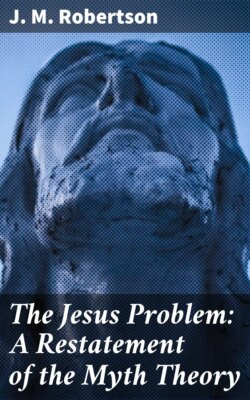Читать книгу The Jesus Problem: A Restatement of the Myth Theory - J. M. Robertson - Страница 15
§ 8. The Suffering Messiah
ОглавлениеBy way of accounting for the Jewish refusal to see in Jesus the promised Messiah, orthodox exegesis has spread widely the belief that it was no part of the Messianic idea that the Anointed One should die an ignominious death; and some of us began by accepting that account of the case. Clearly it was not the traditional or generally prevailing Jewish expectation. Yet in the Acts we find Peter and Paul alike (iii, 18; xvii, 3; xxvi, 23) made to affirm that the prophets in general predicted that Christ should suffer; and in Luke (xxiv, 26–27, 44–46) the same assertion is put in the mouth of Jesus. Either then the exegetes regard these assertions as unfounded or they admit that one school of interpretation in Jewry found a number of “prophetical” passages which foretold the Messiah’s exemplary death. And the A. V. margin refers us to Ps. xxii; Isa. l, 6; liii, 5, etc.; Dan. ix, 26.
Now, these are adequate though not numerous documentary grounds for the doctrine, on Jewish principles of interpretation. Jewish, indeed, the Messianic idea is not in origin: it is Perso-Babylonian;116 and the idea of a suffering or re-arising Messiah may well have come in from that side. But equally that may have found some Jewish acceptance. We can see very well that in Daniel “the Anointed One”—that is, “the Messiah” and “the Christ”—refers to the Maccabean hero; but that as well as the other passages, on Jewish principles, could apply to the Messiah of any period; and the Septuagint reading of Psalm xxii, 16: “They pierced my hands and my feet,” was a specification of crucifixion. It is not impossible that that reading was the result of the actual crucifixion of Cyrus, who had been specified as a “Christ” in Isaiah. We have nothing to do here with rational interpretation: the whole conception of prophecy is irrational; but the construing of old texts as prophecies was a Jewish specialty.
When then a theistic rationalist of the last generation wrote of the gospel Jesus:—
His being a carpenter, occupying the field of barbaric Galilee, and suffering death as a culprit, are not features which the constructor of an imaginary tale would go out of his way to introduce wherewith to associate his hero, and therefore, probably, we have here real facts presented to us,117
he was far astray. Anything might be predicated of a Jewish Messiah. Not only had the Messianic Cyrus been crucified: the anointed and triumphant Judas Maccabæus, under whose auspices the Messianic belief had revived in Israel in the second century B.C., had finally fallen in battle; and his brother Simon, who was actually regarded as the Messiah, was murdered by his son-in-law.118
It is not here argued that the Messianic idea had been originally connected with the Jesus cult; on the contrary that cult is presented as a non-national one, surviving in parts of Palestine in connection with belief in an ancient deity and the practice of an ancient rite, in a different religious atmosphere from that of Messianism. The solution to which we shall find ourselves led is that at a certain stage the Messianic idea was grafted on the cultus; and this stage is likely to have begun after the fall of Jerusalem, when for most Jews the hope of a Maccabean recovery was buried. Then it was that the idea of a Messiah “from above,”119 supernaturally empowered to make an end of the earthly scene, became the only plausible one; and here the conception of a Slain God who, like all slain Gods, rose again, invited the development. Jesuists could now make a new appeal to Jews in general upon recognizably Jewish lines. They were of course resisted, even as Sadducees were resisted by Pharisees, and vice versa. The statement in the Messiah article in the Encyclopædia Biblica that it is highly improbable that “the Jews” at the time of Christ believed in a suffering and atoning Messiah is nugatory. No one ever put such a proposition. But “the Jews” had in course of time added much to their creed, and might have added this, were it not that the Jesus cult became identified with Gentile and anti-Judaic propaganda.
In any case the idea arose among Jews, and quite intelligibly. The picture drawn by Isaiah was a standing incitement to the rise of a cult whose Hero-God had been slain. It was the one kind of Messianic cult which the Romans would leave unmolested. At the same time it committed the devotees to the position that the Messiah must come again, “in the clouds, in great glory”; and the Christian Church was actually established on that conception, which sufficed to sustain it till the earthly Providence of the State came to the rescue. Some of its modern adherents have not hesitated to boast that the common expectation of the speedy end of the world gave the infant Church a footing not otherwise obtainable. It was certainly a conditio sine qua non for Christianity in its infancy.
As for the item of “the carpenter,” we have seen120 not only that that is mythic, but that the myth-theory alone can account for it.
